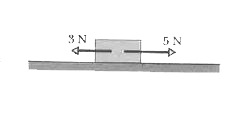In Fig. 5-9, is the magnitude of the normal force →FN greater than, less than, or equal to mg if the block and table are in an elevator moving upward (a) at constant speed and (b) at increasing speed?
(a) equal, (b) greater, ( c ) less
Topper's Solved these Questions
- BOOK - RESNICK AND HALLIDAYCHAPTER - FORCE AND MOTION - I EXERCISE - PROBLEMS52videos
FORCE AND MOTION - I
- BOOK - RESNICK AND HALLIDAYCHAPTER - FORCE AND MOTION - I EXERCISE - PRACTICE QUESTIONS (Single Correct Choice Type)36videos
FORCE AND MOTION - I
- BOOK - RESNICK AND HALLIDAYCHAPTER - FORCE AND MOTION - I EXERCISE - PRACTICE QUESTIONS (Integer Type)3videos
FORCE AND MOTION - I
- BOOK - RESNICK AND HALLIDAYCHAPTER - FLUIDSEXERCISE - PRACTICE QUESTIONS (Integer Type )5videos
FLUIDS
- BOOK - RESNICK AND HALLIDAYCHAPTER - FORCE AND MOTION-IIEXERCISE - PRACTICE QUESTIONS (Integer Type)1videos
FORCE AND MOTION-II
Similar Questions
The suspended body having weighs 75 N. Is T equal to, greater than, or less than 75 N when the body (a) at constant speed, (b) at increasing speed, and ( c ) at decreasing speed?
View SolutionThe rear wheel on a clown's bicycle has twice the radius of the front wheel. (a) When the bicycle is moving, is the linear speed at the very top of the rear wheel greater than, less than, or the same as that of the very top of the front wheel? (b) Is the angular speed of the rear wheel greater than, less than, or the same as that of the front wheel?
View Solution
Knowledge Check
- Question 1 - Select One
Assertion: The magnitude of average velocity of the object over an interval of time is either smaller than or equal to the average speed of the object over the same interval.
Reason: Path length (distance) is either equal or greater than the magnitude of displacement.AIf both assertion & Reason are True & the Reason is a corrrect explanation of the Asserion.BIf both Assertion & Reason are True but Reason is not correct explanation of the Assertion.CIf Assertion is Trie but the Reason is False.DIf both Assertion & Reason are false - Question 2 - Select One
The magnitude of the vector product of two vectors →Aand→B may be -
(a) Greater than AB (b) Equal to AB
(c) Less than AB (d) Equal to ZeroAgreater than ABBequal to ABCless than ABDequal to zero
A block of weight 20 N is placed on a horizontal table and a tension T is applied on the block . Tension can be increased to 8 N before the block begins to slide . A force of 4 N keeps the block moving at constant speed , once it has been set in motion . Find the coefficients of static friction and kinetic friction].
View SolutionThe figure here shows two horizontal forces acting on a block on a frictionless floor. If a third horizontal force →F3 also acts on the block, what are the magnitude and direction of →F3 when the block is (a) stationary and (b) moving to the left with a constant speed of 5 m/s ?
 View Solution
View SolutionAssertion: The magnitude of average velocity of the object over an interval of time is either smaller than or equal to the average speed of the object over the same interval.
Reason: Path length (distance) is either equal or greater than the magnitude of displacement.View SolutionA block lies on a floor. (a) What is the magnitude of the frictional force on it from the floor ? (b) If a horizontal force of 5N is now applied to the block. But the block dose not move. What is the magnitude of the fricition on it ? (c) If the maximum value fcmax of the static frictional force on the block is 10 N, will the block move if the magnitude of the horizontally applied force is 8 N? (d) If it is 12 N ? (e) What is te magnitude of the frictional force in part (c) ?
View SolutionA block A, weighing 100 N is pulled up a slope of length 5 m by means of a constant force F (= 100 N) as illustrated in Fig.

(a) What is the work done by the force F in moving the block A 5 m along the slope ?
(b) What is the increase in potential energy of the block A?
(c) Account for the difference in the work done by the force and the increase in potential energy of the blockView SolutionDiscuss what happens if a satellite is projected with a horizontal speed (1) less than the critical orbital speed (2) equal to the critical orbital speed (3) more than the critical orbital speed but less than the escape speed (4) greater than or equal to the escape speed.
View Solution

